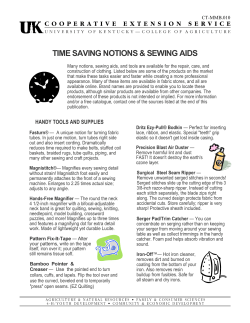
Elastic … The Notion That Gives Elastic is a flexible, stretch-
Elastic … The Notion That Gives 6.145 Page 1 Elastic is a flexible, stretchable, narrow fabric. Elastic is made from a series of rubber (or stretchable synthetic, such as spandex) cores that are bound or wrapped in polyester, cotton, nylon or a blend of fiber threads. The exterior threads are braided, woven or knit together to create the elastic. It comes in a variety of thicknesses and widths; different elastics have more or less stretch. Elastic can be threaded through casings or stitched directly to the fabric to control fullness in a particular area. Good quality elastic stretches more than twice its length and then returns to its original shape and length. Quality and behavior are determined by the elastic’s construction and fiber content. Most elastics are between 1/8" and 2 1/2" wide, although elastic thread is narrower and decorative elastic waistbands can be extra wide. Elastic Construction & Fiber Content Elastic is categorized by how it’s constructed and its fiber content. Each plays a role in how the elastic behaves and how it should be used. Elastics are categorized as either braided, knitted, woven or transparent. From left to right: Braided Elastic, Knitted Elastic and Woven Elastic Braided elastic is used inside casings because it narrows when it’s stretched, and it looses its stretch and shape retention when it’s pierced or stitched through. Braided elastic has distinctive lengthwise, parallel ribs and is used primarily on sleeve hems, swimwear and leg bands. Knitted elastic is soft, strong and appropriate for most apparel items. Because it’s lightweight, it’s best-suited for lightweight fabrics. It doesn’t narrow when stretched and is not affected by needle piercing, making it as Dictionary suitable for direct Casing—a closed fabric application tunnel that encases a as it is for casings. drawstring or length Woven elastic is of elastic. Used to very strong and control fullness usually thicker around the waist, at than the other the neckline or at the elastics. It’s used lower edge of a on heavy weight sleeve or pant leg. fabrics, including Direct application— home decorating attaching elastic to fabric, car covers, fabric by sewing bags, accessories, directly through the etc. It has both elastic and fabric, crosswise and stretching the elastic lengthwise ribs, to fit the fabric as you giving it a sew. windowpane appearance. It does not narrow when stretched, nor does needle piercing weaken it. Therefore, it can be used in casings or stitched directly to the fabric. Transparent polyurethane, also called clear elastic, is not braided, knitted or woven. It’s a synthetic product that stretches three to four times its length with complete recovery to its original size and shape. It’s used for direct fabric application and seems to be gaining popularity. Elastic … The Notion That Gives 6.145 Page 2 Fiber Content Sewing With Elastics Almost all elastic is made with rubber cores; although rubber-free elastic can be found for use in medical supplies and for people with latex allergies. Clear elastic is rubber-free. Generally, the higher the rubber content in the elastic, the greater the stretch. Most elastic is a combination of rubber with polyester, cotton or nylon. The most versatile and most common elastics are a blend of rubber and polyester. They are suitable for wash-and-wear fabrics, synthetic knits and swimwear. Even dry-clean-only items can use polyester/rubber elastic. If you aren’t sure which elastic to use, stick with polyester. Nylon/rubber elastic has a soft luster and is used on swimwear and lingerie. It is machine washable, but should be dried in medium heat. Cotton/rubber elastic does shrink, but not a lot. It should not be dry-cleaned. It is ideal for wash-and-wear fabrics and can be dried in medium to high temperatures. It is perfect for the natural-fiber lover. Choosing Elastic There are different kinds of elastic available; many types of elastic have been developed for specific sewing tasks. A brief review of the various elastic types is available in Guideline 22.210; however, as a general rule, select an elastic that has the same care requirements as the finished garment. Refer to the packaging for information about the best use for a particular type of elastic. Only use elastic that recovers to its original length after stretching. Braided elastic narrows when it’s stretched, so only use it inside casings. Knitted and woven elastics can be used in casings or stitched directly to the fabric. • Choose thread that is compatible with the fabric. • Use a ball-point needle. • Watch the thread tension; you may need to adjust it when stitching and stretching elastic. • The elastic needs to be snug enough to prevent the fabric from drooping, but loose enough to be comfortable. • To ensure comfort in garments, wrap the elastic around your body, and pin it closed. Wear it for a half hour, and adjust the length as needed. • Cut elastic the desired length plus 1" for finishing the ends. • When sewing elastic directly to fabric, cut it about 8 percent shorter that the desired length; it does stretch during stitching. • Use a long straight stitch or a zigzag to sew elastic directly to fabric. • Look for the Elastic Wizard ™ by Bonfit®, a specialty presser foot/machine attachment that applies elastic without having to stretch it by hand, guaranteeing consistent gathers. Credit: All elastic samples are courtesy of Rhode Island Textile Company. 1/06
© Copyright 2025










